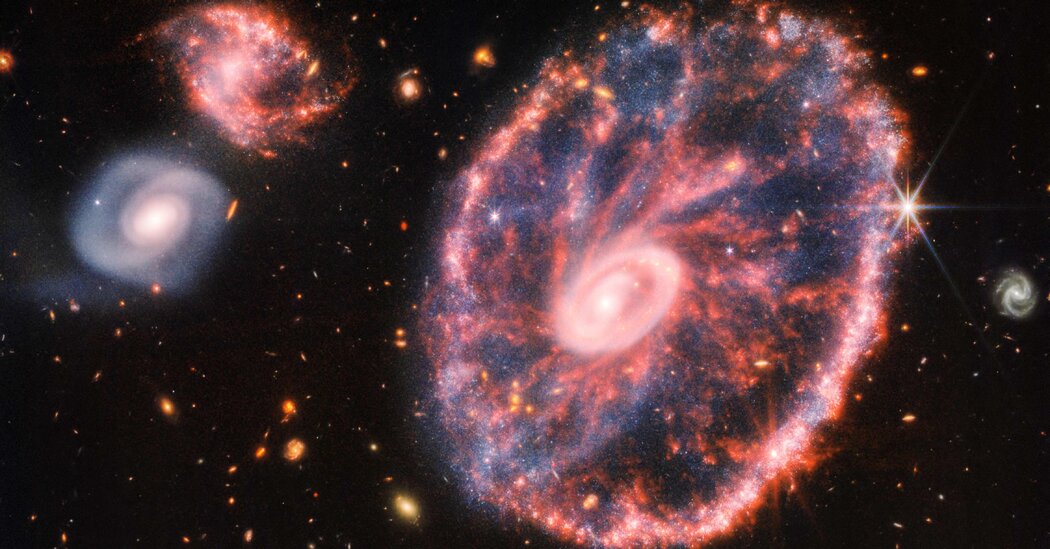The Cartwheel Galaxy Is the Webb Telescope’s Latest Cosmic Snapshot

Scientists on Tuesday published the latest images from NASA’s triumphant James Webb Space Telescope. The newest release documents the Cartwheel galaxy, which is about 500 million light-years from our planet and is aptly named for its wheel-like appearance, complete with a center hub, a tire and even wavy, fluorescent spokes. The Webb also recorded two smaller companion galaxies alongside Cartwheel.
The new images come on the heels of NASA’s July 12 unveiling of five initial scenes captured by the Webb telescope, the most powerful space observatory built to date. Since they were launched on Dec. 25, the Webb’s 18 hexagonal gold mirrors have aligned to capture other targets in space, though not all images have been released. Snapshots have included the Southern Ring nebula, which resembles a soap bubble expanding from a dead star, and the striking Carina nebula, composed of swirling dust akin to jagged cliffs.
Astronomers have been studying the Cartwheel galaxy for decades. Initially, it was inspected from two ground observatories in Australia, first the UK Schmidt telescope and later the Anglo-Australian telescope. But it is best known from the Hubble Space Telescope, which produced images in the 1990s with more details of the galaxy’s makeup. And just as the Webb, in July, revealed the presence of even more distant galaxies hiding from our view, its photographs of Cartwheel magnified the detailed formation of stars within the galaxy’s rings and the dozens of other star systems beyond.
Cartwheel’s appearance comes from a collision of two galaxies that occurred hundreds of million of years ago. “We guess that the Cartwheel probably started out looking something like the Milky Way, and then this other galaxy moved through,” said Marcia Rieke, principal investigator of the near-infrared camera, or NIRCam, one of the Webb telescope’s scientific instruments. The smaller galaxy, though, rather than getting stuck in the large spiral it penetrated, continued on, moving away from the larger one. It is not visible in the image NASA published.
Galactic collisions are not uncommon in deep space, though it is rare for them to result in such a perfect shape that sparks human curiosity. Kirk Borne, who was the principal investigator for the Hubble observation of the Cartwheel but was not involved with the Webb, said that the galaxy’s strange shape, which formed by coincidence during the merger, has motivated astronomers to study it for decades.
Because a smaller galaxy crashed into a larger one — and straight through its middle — it was less disruptive to the shape of each galaxy, and both were relatively able to maintain their individuality. “What changed the Cartwheel’s shape was the influence of this other galaxy’s gravitational field that changed the orbits of stars in the original Cartwheel galaxy,” Dr. Rieke said.
Dr. Borne, who has studied other collisions of galaxies, described the smaller galaxy as a bullet that shot through the large one. After the observation of the cosmic object in the 1990s, the scientists noticed a trail of hydrogen gas left behind that was following the smaller galaxy, which Dr. Borne called the “smoking gun” indicating that it had kept moving after creating Cartwheel’s new formation.
Already 1.5 times the size of the Milky Way, Cartwheel is still expanding, and new stars are being formed both inside its outer ring and at its edge. However, there is no concrete answer on how large Cartwheel will become, when it will stop growing or what shape it will take when it does.
The images of Cartwheel were already in hand on July 12, though they were not available to the public until this week. They have been filtered to make them more visually accessible, highlighting vivid, blue-hued young stars and red-toned molecules from older stars and space dust floating between the rings. While colorful, Joseph DePasquale, a senior science visuals developer at the Space Telescope Science Institute, which manages the Webb and Hubble spacecraft, emphasized that the stars and dust are actually detected as infrared light instead of colors.
The new technology to detect that light in such detail is what distinguishes Webb’s images from those made by Hubble and the Anglo-Australian telescope. While Hubble had some capabilities to record light in the infrared spectrum, Webb’s are more advanced and create more vibrant pictures. The NIRCam, for instance, which was built by about 25 people working with Dr. Rieke over 11 years, distinguishes the stars’ infrared colors, which are invisible to the human eye, from one another.
When Hubble captured Cartwheel in the 1990s, the galaxy’s “spokes” were obscured by gas clouds that scattered light, making it hard to see the thousands of stars forming within. Now, because the Webb can study mid-infrared and near-infrared light wavelengths, it is able to filter past the space dust. That helps to confirm some of the theories of Cartwheel’s makeup that were formed using Hubble’s technology and to uncover new information, such as the lack of star formation in some areas between the spokes of the wheel.
“I think the combination of the two telescopes, far from making one of them obsolete, this is actually just boosting the benefits and power of Hubble because now we can do these comparisons,” Dr. Borne said.